Bayon Temple Cambodia Defines A Journey Through Ancient Khmer History
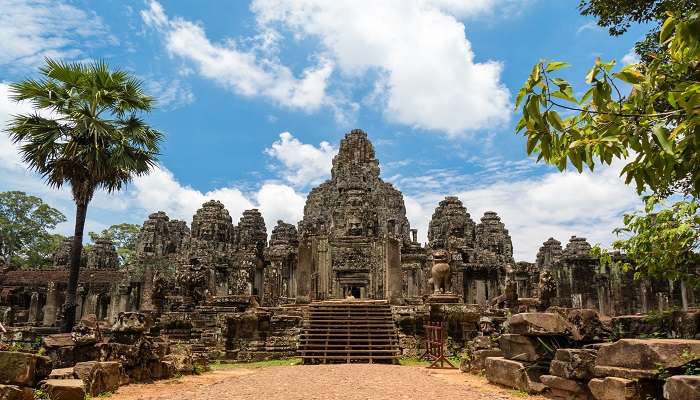
In the ancient ruins of Angkor, the Bayon Temple Cambodia stands out as a mysterious and stunning structure from the Khmer Empire. Built in the late 12th or early 13th century as King Jayavarman VII’s official state temple, it combines religious symbolism, intricate artistry, and impressive grandeur. Approaching the temple, you’ll be struck by a remarkable sight of towers adorned with numerous huge stone faces. Every part of its sandstone surfaces showcases the incredible skill of Khmer sculptors, whose craftsmanship has endured through the ages.
About Bayon Temple Cambodia
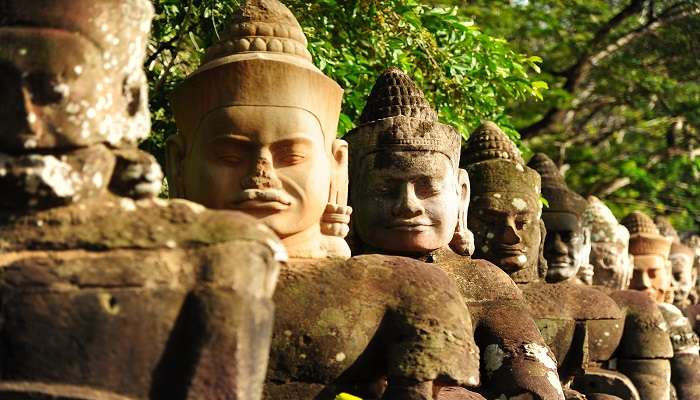
The Bayon Temple, Cambodia’s crown jewel, is a richly decorated Khmer temple located at Angkor. Built in the late 12th or early 13th century by King Jayavarman VII, it is the centrepiece of his capital, Angkor Thom. The Bayon’s defining feature is the captivating display of serene, enigmatic faces. These are most likely representations of the Buddha. Some believe they were modelled after King Jayavarman VII himself. These faces gaze out from all sides of the numerous towers that jut from the upper terrace and cluster around the temple’s central peak. The Bayon wasn’t just a monument to serenity; it also held deep Buddhist symbolism. Interestingly, the Bayon is the last state temple constructed at Angkor and, uniquely, the only one built primarily to honour Buddhist deities.
Must Read: Explore The Ancient Marvel of Angkor At Prasat Ta Keo
History Of Bayon Temple Cambodia
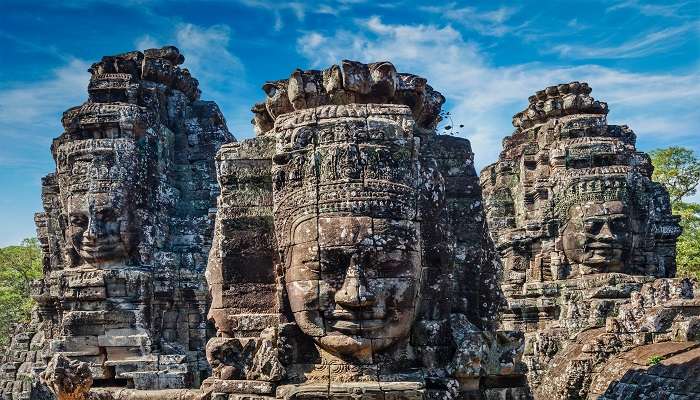
The Bayon Cambodia boasts a rich history. Built during the reign of King Jayavarman VII (1181-1220 CE) and the evolution of Khmer Buddhism, it was constructed in the late 12th or early 13th century. The exact date of its construction is shrouded in mystery. The Bayon was the centrepiece of Jayavarman’s grand capital, Angkor Thom. Though originally conceived as a Hindu temple, the Bayon reflects a king who broke with tradition. Jayavarman VII embraced Theravada Buddhism, a branch of Mahayana Buddhism, and this is evident in the temple’s design and imagery. The Bayon’s most striking feature is undoubtedly the multitude of serene faces carved into its towers. These enigmatic sculptures, numbering around 216, are a source of ongoing debate. Initially, scholars believed them to represent the four-headed Hindu god Brahma, the creator. However, the prevailing theory suggests they depict Lokeshvara (or Avalokiteshvara), the Mahayana bodhisattva of compassion. Interestingly, it’s highly probable that the faces were modelled after Jayavarman VII himself. This connection between the king and the divine reinforces the Bayon’s role as a royal temple and mausoleum.
The architecture of Bayon Temple Cambodia

The Bayon Temple Cambodia stands out as a truly unique architectural wonder, attracting visitors with its design and enigmatic beauty. The temple is oriented towards the east, positioning its buildings toward the west within enclosures that stretch along the east-west axis. Situated precisely at the centre of Angkor Thom, roads lead directly to the temple from the gates at each city’s cardinal point. Unlike Angkor Wat, the temple has no walls or moats; the city’s fortifications replace these. This city-temple arrangement covers an area of 9 square kilometres, significantly larger than Angkor Wat’s 2 square kilometres to the south. Within the temple are two galleried enclosures (the third and second enclosures) and an upper terrace (the first enclosure), all densely packed together with minimal space between them.
Suggested Read: Ta Prohm Temple
1. The Outer Gallery
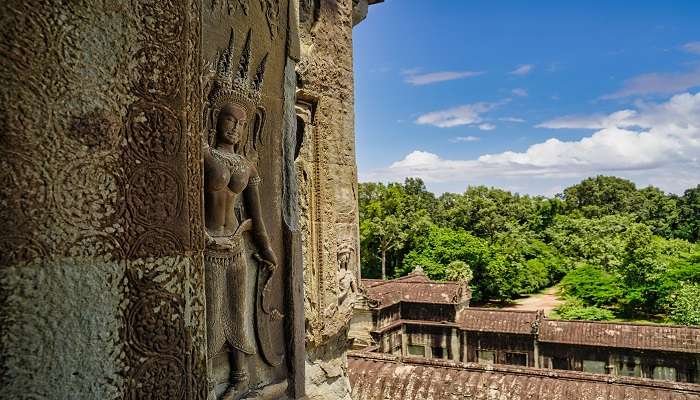
The outer wall of the outer gallery features a series of bas-reliefs depicting historical events and scenes from the everyday life of the Angkorian Khmer. The outer gallery encloses a courtyard housing two libraries (one on either side of the east entrance). Originally, the courtyard contained 16 chapels, which were later demolished by the Hindu restorationist Jayavarman VIII.
2. The Inner Gallery
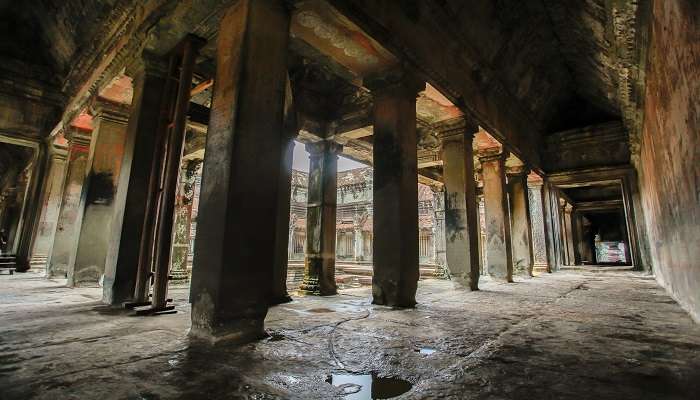
The inner gallery, elevated above ground level with doubled corners, originally had a redented cross-shape, later filled out to a square. Its bas-reliefs, additions by Jayavarman VIII, starkly contrast with those of the outer gallery. Instead of set-piece battles and processions, the smaller canvases of the inner gallery primarily depict scenes from Hindu mythology.
Suggested Read: Phnom Kraom
3. The Upper Terrace
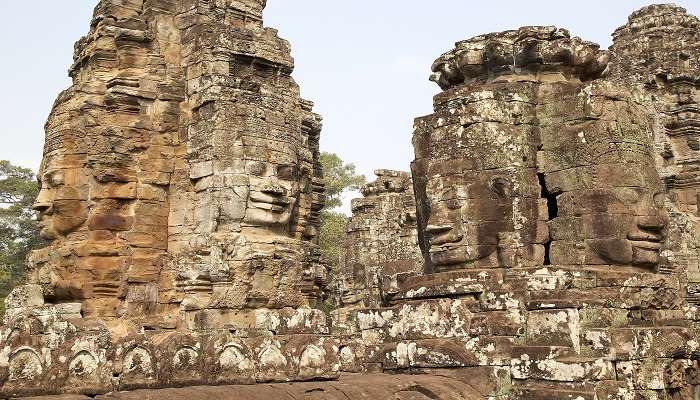
The upper terrace houses the famous “face towers” of the Bayon, each supporting two, three, or, most commonly, four gigantic smiling faces. Smaller towers are located along the inner gallery and on chapels on the upper terrace. Over time, efforts have been made to interpret the significance of the number of towers and faces as towers have been added and lost. At one point, the temple had 49 towers; now, only 37 remain. The number of faces is approximately 200, but a definitive count is impossible due to partial preservation.
4. The Central Tower and Sanctuary
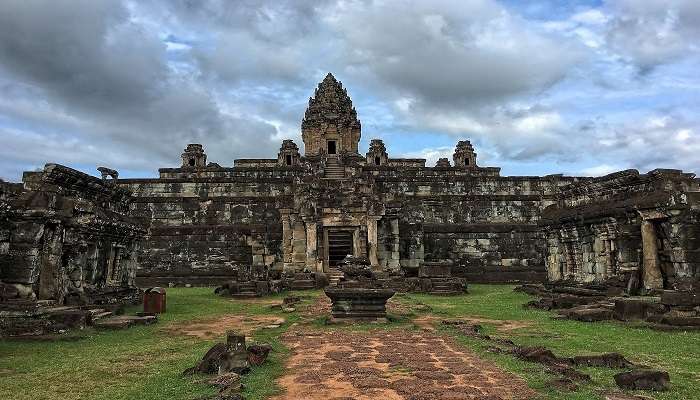
Like the inner gallery, the central tower was initially cruciform but later modified to a circular shape, rising 43 meters above the ground. At the temple’s foundation, the principal religious image was a 3.6-meter-tall statue of the Buddha in meditation, shielded by the flared hood of the serpent king Mucalinda. During the reign of the Hindu restorationist monarch Jayavarman VIII, the statue was removed from the sanctuary and smashed. In 1933, it was recovered from the bottom of a well, pieced back together, and is now displayed in a small pavilion at Angkor.
Suggested Read: Angkor Archaeological Park
Things To Do At Bayon Temple Cambodia
Exploring Bayon Angkor Wat, Cambodia, is a captivating experience. Some of the things you can do to make the most of your visit:
1. Witness the Intricate Bas-Reliefs
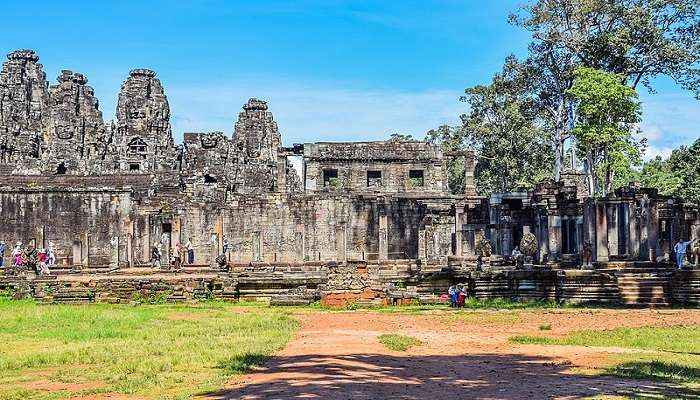
Bayon is famous for the hundreds of serene and enigmatic smiling faces carved into its towers. These faces are believed to represent the bodhisattva Avalokiteshvara, the Buddhist embodiment of compassion. The temple walls are also adorned with extensive bas-reliefs depicting scenes from everyday life in the Khmer Empire, including battles, markets, and religious ceremonies.
Suggested Read: Thommanon Temple
2. Ascend the Central Tower for Panoramic Views:
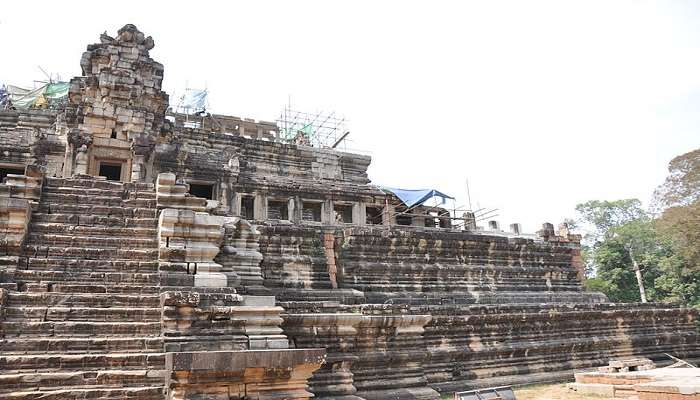
The Bayon temple has a central tower that rises above the surrounding terraces. Climbing to the top provides stunning panoramic views of the Angkor Thom complex, including the Terrace of the Elephants and the Phimeanakas Pyramid. The climb allows visitors to appreciate the intricate details of the temple’s stone faces up close and witness the unique perspective of the temple’s historical and architectural significance.
3. Explore the Terrace of the Elephants
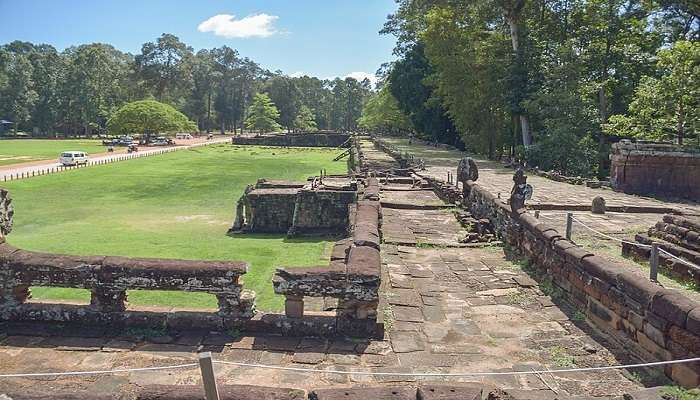
Located directly next to the Bayon, the Terrace of the Elephants was once used by the king for public ceremonies and reviewing his troops. The terrace is decorated with impressive carvings of elephants and other animals and scenes from Hindu mythology, showing the grandeur and autistic excellence of the Khmer Empire.
Suggested Read: Choeung Ek Genocidal Center
4. Watch the Sunrise Over the Temple Complex
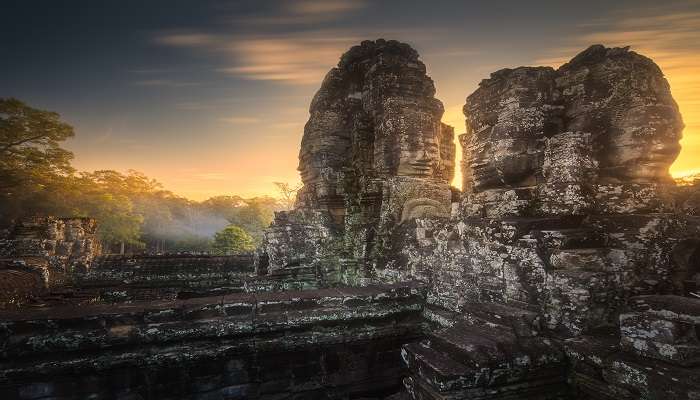
Angkor Wat is the most famous temple to watch the sunrise over, but the Bayon can also be a magical sight in the early morning light. Seeing the temple emerge from the darkness as the sun rises is a truly unforgettable experience.
5. Enjoy a Traditional Dance Performance
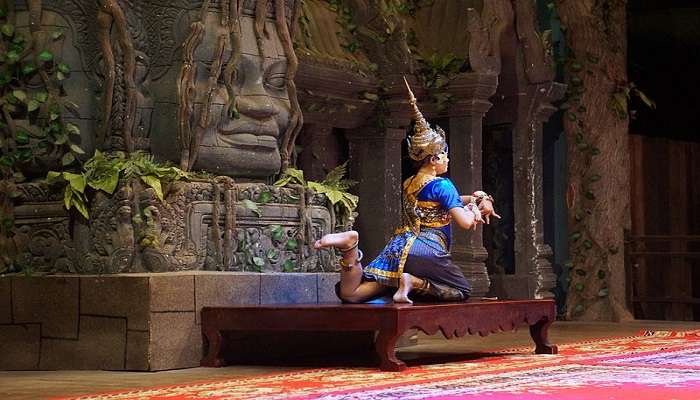
In the evening, you can enjoy a traditional Khmer dance performance near the Angkor Wat complex. These performances are a great way to learn about Cambodian culture and see some of the country’s beautiful costumes and music.
Suggested Read: Banteay Srei Cambo
Bayon Temple Cambodia Timings And Best Time to Visit
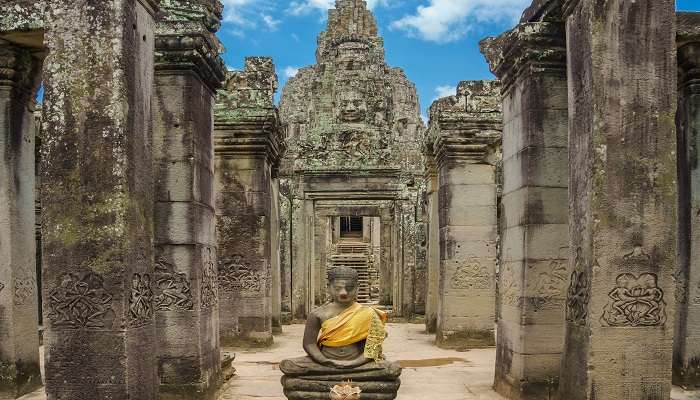
The Bayon Temple is open daily from 7:30 AM to 5:30 PM. You can purchase your Angkor Pass between 5 AM and 5:30 PM at the official ticketing office, 4 kilometres from Siem Reap town. Tickets purchased after 5 PM are valid only from the next day. There is no separate entrance fee for Bayon Temple.
The best time to visit Bayon Temple is during the dry season in Cambodia, from November to April, which offers the most pleasant weather for exploring the temples. However, this is also the peak tourist season. The rainy season (May to October) can be hot and humid, but fewer crowds exist.
How To Reach Bayon Temple Cambodia?
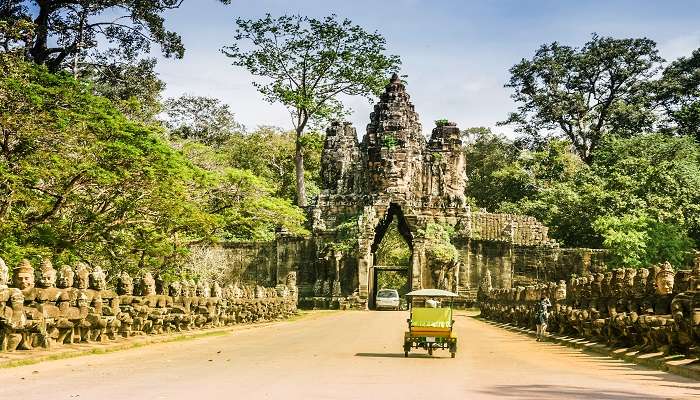
Reaching Bayon Temple involves several transportation options depending on your starting point.
1. By Air
Siem Reap International Airport (REP) is the nearest international airport to Bayon Temple. You can take a Taxi, Tuk-tuk, or ride-sharing service from the airport to reach Angkor Wat, the main complex where Bayon Temple is situated. The ride takes about 20-30 minutes. Alternatively, some hotels offer pre-booked transfers from the airport directly to your hotel.
2. By Road
Bayon Temple is about 10 kilometres north of Siem Reap town.
- Bus
Several bus companies operate daily services between Phnom Penh and Siem Reap. Depending on the service, the journey takes about 5-7 hours. - Tuk-tuk
A popular and affordable travel method, tuk-tuks can be hired for a day or specific trips. The ride from Siem Reap to Bayon Temple typically takes 20-30 minutes. - Taxi
Taxis are more comfortable than tuk-tuks, and taxis can also be hired for the day or specific trips. The journey is faster and costs more, but it offers air-conditioned comfort. - Bicycle
For a more adventurous and eco-friendly option, renting a bicycle is a great way to explore the temples at your own pace. The ride takes about 45 minutes to an hour. - Motorbike
Renting a motorbike is another flexible option, allowing you to navigate the park quickly. Ensure you have the necessary permits and follow local traffic laws.
Further Read: Koh Ker Temple Cambodia
Whether you’re a history buff, an architecture enthusiast, or simply someone seeking to immerse themselves in the rich tapestry of Cambodian heritage, the Bayon Temple is an absolute must-visit destination. Are you inspired to explore this extraordinary wonder firsthand? Plan your trip to Cambodia today and let the enigmatic allure of the Bayon Temple captivate you. Uncover the secrets of this ancient masterpiece and create memories that will last a lifetime. Don’t miss the opportunity to witness one of the world’s most awe-inspiring archaeological sites.
For our editorial codes of conduct and copyright disclaimer, please click here.
Cover Image Source: Shutterstock
Frequently Asked Questions About Bayon Temple Cambodia
What is special about Bayon Temple?
The Bayon Temple is renowned for its intricate decorations. The Bayon is primarily known for its numerous towers adorned with serene and smiling stone faces and its two sets of bas-reliefs that depict a mix of mythological, historical, and everyday scenes.
What is the difference between Bayon Temple and Angkor Wat?
While both are significant Khmer temples, Bayon and Angkor Wat differ in several ways. Unlike Angkor Wat's grandeur, Bayon appears less impressive from afar. Bayon is unique as it's the only Angkorian state temple primarily dedicated to Buddhist worship. In contrast, Angkor Wat was initially a Hindu temple for the god Vishnu. Bayon's towers' numerous serene and smiling stone faces set it apart from Angkor Wat.
Why is Bayon famous?
Bayon is celebrated for its distinctive architecture and decorations. The temple's numerous towers feature serene and smiling stone faces, believed to represent The Buddha and possibly King Jayavarman VII. Additionally, Bayon's bas-reliefs, which depict various scenes from mythology, history, and daily life, contribute to its fame.
What was found at the Bayon temple?
During conservation efforts, a 12-foot-tall statue of the Buddha was discovered at the bottom of a nearby well. Additionally, a statue of the main idol, a seated Buddha sheltered under the hoods of the snake Mucalinda, was found in a pit under the main shrine.
Whose face is on the Bayon temple?
The faces on the Bayon temple are generally believed to represent the Bodhisattva of Compassion, Avalokitesvara. However, due to their resemblance to other statues of the king, many scholars believe that these faces are depictions of King Jayavarman VII himself. The exact symbolism of these faces remains a subject of ongoing research.
People Also Read:
Devipattinam Navagraha Temple Pura Taman Kemuda Saraswati Chamundeshwari Temple

Passionate Marketing Student with a flair for storytelling, eagerly embarking on a journey within the vibrant world of travel. Excited to merge analytical acumen with creative skills to elevate the editorial landscape of the travel industry.











